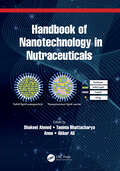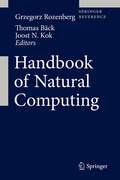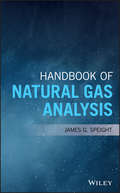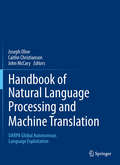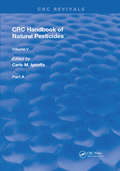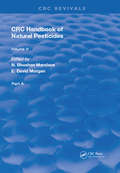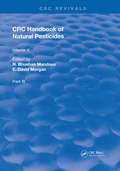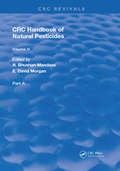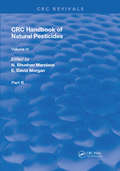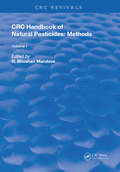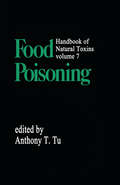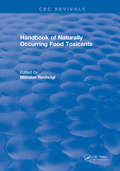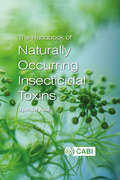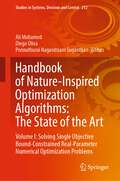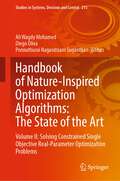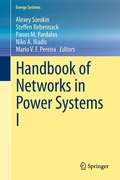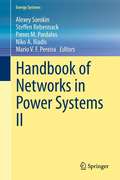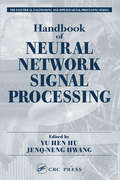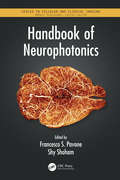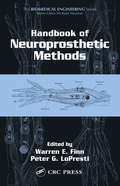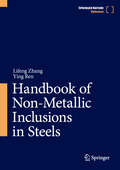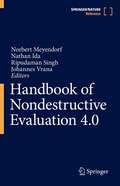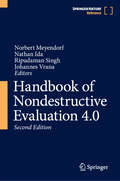- Table View
- List View
Handbook of Nanotechnology in Nutraceuticals
by Shakeel Ahmed Tanima Bhattacharya Annu Akbar AliNanotechnology has been emerging as an important tool in the nutraceutical and food industries to improve the overall quality of life. Nanotechnology has established a new horizon by bestowing modified properties on nanomaterials and applying them to the production of nanoformulations, nutritional supplements, and the food industry. The Handbook of Nanotechnology in Nutraceuticals highlights the impact of nanotechnology on the food industries. The book focuses on the application of nanotechnology in nutraceuticals and the food industry to improve the overall quality of life. The book also addresses some important applications of nano-nutraceuticals in the treatment of different diseases, such as oxidative stress, cancer, neurodegenerative disorders, cardiovascular diseases, and so on. Features • Presents a scientometric approach to analyze the emergence of nano-nutraceuticals in cancer prevention and treatment • Examines various strategies employed to prepare nanocarrier systems, such as nanoparticles, nanostructure lipids, phospholipid-based nanocarriers, polysaccharide-based nanostructures, and metal nanoparticles • Discusses various regulatory issues related to nanotechnology and their application in different fields This book is a valuable reference for nanotechnologists, scientists, and researchers working in the field of food technology, food science, pharmaceuticals, and nutraceuticals.
Handbook of Natural Computing
by Thomas Bäck Grzegorz Rozenberg Joost N. KokNatural Computing is the field of research that investigates both human-designed computing inspired by nature and computing taking place in nature, i.e., it investigates models and computational techniques inspired by nature and also it investigates phenomena taking place in nature in terms of information processing. Examples of the first strand of research covered by the handbook include neural computation inspired by the functioning of the brain; evolutionary computation inspired by Darwinian evolution of species; cellular automata inspired by intercellular communication; swarm intelligence inspired by the behavior of groups of organisms; artificial immune systems inspired by the natural immune system; artificial life systems inspired by the properties of natural life in general; membrane computing inspired by the compartmentalized ways in which cells process information; and amorphous computing inspired by morphogenesis. Other examples of natural-computing paradigms are molecular computing and quantum computing, where the goal is to replace traditional electronic hardware, e.g., by bioware in molecular computing. In molecular computing, data are encoded as biomolecules and then molecular biology tools are used to transform the data, thus performing computations. In quantum computing, one exploits quantum-mechanical phenomena to perform computations and secure communications more efficiently than classical physics and, hence, traditional hardware allows. The second strand of research covered by the handbook, computation taking place in nature, is represented by investigations into, among others, the computational nature of self-assembly, which lies at the core of nanoscience, the computational nature of developmental processes, the computational nature of biochemical reactions, the computational nature of bacterial communication, the computational nature of brain processes, and the systems biology approach to bionetworks where cellular processes are treated in terms of communication and interaction, and, hence, in terms of computation. We are now witnessing exciting interaction between computer science and the natural sciences. While the natural sciences are rapidly absorbing notions, techniques and methodologies intrinsic to information processing, computer science is adapting and extending its traditional notion of computation, and computational techniques, to account for computation taking place in nature around us. Natural Computing is an important catalyst for this two-way interaction, and this handbook is a major record of this important development.
Handbook of Natural Gas Analysis
by James G. SpeightA comprehensive resource to the origin, properties, and analysis of natural gas and its constituents Handbook of Natural Gas Analysis is a comprehensive guide that includes information on the origin and analysis of natural gas, the standard test methods, and procedures that help with the predictability of gas composition and behavior during gas cleaning operations and use. The author—a noted expert on the topic—also explores the properties and behavior of the various components of natural gas and gas condensate. All chapters are written as stand-alone chapters and they cover a wealth of topics including history and uses; origin and production; composition and properties; recovery, storage, and transportation; properties and analysis of gas stream and gas condensate. The text is designed to help with the identification of quality criteria appropriate analysis and testing that fall under the umbrella of ASTM International. ASTM is an organization that is recognized globally across borders, disciplines and industries and works to improve performance in manufacturing and materials and products. This important guide: Contains detailed information on natural gas and its constituents Offers an analysis of methane, gas hydrates, ethane, propane, butane, and gas condensate Includes information on the behavior of natural gas to aid in the planning for recovery, storage, transportation, and use Covers the test methods that are applicable to natural gas and its constituents Written in accessible and easy-to-understand terms Written for scientists, engineers, analytical chemists who work with natural gas as well as other scientists and engineers in the industry, Handbook of Natural Gas Analysis offers a guide to the analysis, standard test methods, and procedures that aid in the predictability of gas composition and behavior during gas cleaning operations and use.
Handbook of Natural Language Processing and Machine Translation: DARPA Global Autonomous Language Exploitation
by Caitlin Christianson Joseph Olive John MccaryThis comprehensive handbook, written by leading experts in the field, details the groundbreaking research conducted under the breakthrough GALE program--The Global Autonomous Language Exploitation within the Defense Advanced Research Projects Agency (DARPA), while placing it in the context of previous research in the fields of natural language and signal processing, artificial intelligence and machine translation. The most fundamental contrast between GALE and its predecessor programs was its holistic integration of previously separate or sequential processes. In earlier language research programs, each of the individual processes was performed separately and sequentially: speech recognition, language recognition, transcription, translation, and content summarization. The GALE program employed a distinctly new approach by executing these processes simultaneously. Speech and language recognition algorithms now aid translation and transcription processes and vice versa. This combination of previously distinct processes has produced significant research and performance breakthroughs and has fundamentally changed the natural language processing and machine translation fields. This comprehensive handbook provides an exhaustive exploration into these latest technologies in natural language, speech and signal processing, and machine translation, providing researchers, practitioners and students with an authoritative reference on the topic.
Handbook of Natural Pesticides: Microorganisms, Part A, Volume V
by N. Bhushan MandavaThis handbook series includes several naturally occurring chemicals that exhibit biological activity. These chemicals are derived from plants, insects, and several microorganisms. Volume I of this series is covers the theory and practice of the strategies for pest control and methods for detection.Moreover, it presents extensive tables that provide the information you need to select the most appropriate bioassay for a particular plant growth regulator or hormone. In addition to the chapters on bioassays, Volume I provides a solid introduction to the theory and practice of natural pesticide use, including in-depth discussions of integrated management systems for weed and pest control, the state-of-the-art use of computers in pest management, and allelochemicals as natural protection. Guidelines on toxicological testing and EPA regulation of natural pesticides are also detailed.
Handbook of Natural Pesticides: Part A, Volume III
by N. Bhushan MandavaThis handbook series includes several naturally occurring chemicals that exhibit biological activity. These chemicals are derived from plants, insects, and several microorganisms. Volume I of this series is covers the theory and practice of the strategies for pest control and methods for detection.Moreover, it presents extensive tables that provide the information you need to select the most appropriate bioassay for a particular plant growth regulator or hormone. In addition to the chapters on bioassays, Volume I provides a solid introduction to the theory and practice of natural pesticide use, including in-depth discussions of integrated management systems for weed and pest control, the state-of-the-art use of computers in pest management, and allelochemicals as natural protection. Guidelines on toxicological testing and EPA regulation of natural pesticides are also detailed.
Handbook of Natural Pesticides: Part B, Volume III
by N. Bhushan MandavaThis handbook series includes several naturally occurring chemicals that exhibit biological activity. These chemicals are derived from plants, insects, and several microorganisms. Volume I of this series is covers the theory and practice of the strategies for pest control and methods for detection.Moreover, it presents extensive tables that provide the information you need to select the most appropriate bioassay for a particular plant growth regulator or hormone. In addition to the chapters on bioassays, Volume I provides a solid introduction to the theory and practice of natural pesticide use, including in-depth discussions of integrated management systems for weed and pest control, the state-of-the-art use of computers in pest management, and allelochemicals as natural protection. Guidelines on toxicological testing and EPA regulation of natural pesticides are also detailed.
Handbook of Natural Pesticides: Pheromono, Part A, Volume IV
by N. Bhushan MandavaThis handbook series includes several naturally occurring chemicals that exhibit biological activity. These chemicals are derived from plants, insects, and several microorganisms. Volume I of this series is covers the theory and practice of the strategies for pest control and methods for detection.Moreover, it presents extensive tables that provide the information you need to select the most appropriate bioassay for a particular plant growth regulator or hormone. In addition to the chapters on bioassays, Volume I provides a solid introduction to the theory and practice of natural pesticide use, including in-depth discussions of integrated management systems for weed and pest control, the state-of-the-art use of computers in pest management, and allelochemicals as natural protection. Guidelines on toxicological testing and EPA regulation of natural pesticides are also detailed.
Handbook of Natural Pesticides: Pheromono, Part B, Volume IV
by N. Bhushan MandavaThis handbook series includes several naturally occurring chemicals that exhibit biological activity. These chemicals are derived from plants, insects, and several microorganisms. Volume I of this series is covers the theory and practice of the strategies for pest control and methods for detection.Moreover, it presents extensive tables that provide the information you need to select the most appropriate bioassay for a particular plant growth regulator or hormone. In addition to the chapters on bioassays, Volume I provides a solid introduction to the theory and practice of natural pesticide use, including in-depth discussions of integrated management systems for weed and pest control, the state-of-the-art use of computers in pest management, and allelochemicals as natural protection. Guidelines on toxicological testing and EPA regulation of natural pesticides are also detailed.
Handbook of Natural Pesticides: Volume I: Theory, Practice, and Detection (Crc Series In Naturally Occurring Pesticides)
by N. Bhushan MandavaThis handbook series includes several naturally occurring chemicals that exhibit biological activity. These chemicals are derived from plants, insects, and several microorganisms. Volume I of this series is covers the theory and practice of the strategies for pest control and methods for detection.Moreover, it presents extensive tables that provide the information you need to select the most appropriate bioassay for a particular plant growth regulator or hormone. In addition to the chapters on bioassays, Volume I provides a solid introduction to the theory and practice of natural pesticide use, including in-depth discussions of integrated management systems for weed and pest control, the state-of-the-art use of computers in pest management, and allelochemicals as natural protection. Guidelines on toxicological testing and EPA regulation of natural pesticides are also detailed.
Handbook of Natural Toxins: Food Poisoning
by Anthony T. TuThis resource discusses all aspects of food poisoning and its sources such as bacteria, plant, and fungus - presenting the pathogens and food toxins in detail. Featuring contributions from over 30 leading authorities in the field, Food Poisoning ...: describes bacterial food contaminants including staphylococcal, salmonellae, E. coli, Clostridium perfringens, Bacillus cereus, cholera, and botulism; covers the prevention and treatment of mushroom and other poisonings from grains and plant-type foods; explains how to aid allergic reactions resulting from eating certain foods; identifies which kinds of seafood may cause severe poisoning; explores teratogenic aspects of food poisoning, outlining which foods pregnant women should avoid; and shows how those sensitive to nitrosamines can avoid such food poisoning.;Extensively referenced with more than 2200 literature citations, Volume 7: Food Poisoning serves as essential reading for toxicologists, microbiologists, dietitians and nutritionists, public health officials, food scientists and technologists, agricultural chemists and biochemists, bacteriologists, and graduate-level students in food science and toxicology.
Handbook of Naturally Occurring Food Toxicants (Crc Series In Nutrition And Food)
by Miloslav RechciglIn the last decade an increased concern has been voiced against various environmental hazards, particularly chemicals that may cause harm to humans or animals. Numerous studies which have dealt with this subject invariably have focused on chemical contaminants of some component of a food chain. In contrast, much less attention has been paid to the potentially harmful substances that may occur in foodstuffs naturally. The purpose of this Handbook is to sensitize the reader to this problem and to provide a systematic overview of the most important naturally occurring food toxicants. The Handbook should be of interest to anybody who is concerned with nutritive and health aspects of food. Inasmuch as many of the discussed toxicants can be removed or destroyed by a suitable method of food rpocessing it should be of special value to food technologists.
Handbook of Naturally Occurring Insecticidal Toxins, The
by Opender KoulNaturally occurring toxins are among the most complicated and lethal in existence. Plant species, microorganisms and marine flora and fauna produce hundreds of toxic compounds for defence and to promote their chances of survival, and these can be isolated and appropriated for our own use. Many of these toxins have yet to be thoroughly described, despite being studied for years. Focusing on the natural toxins that are purely toxic to insects, this book contains over 500 chemical structures. It discusses the concepts and mechanisms involved in toxicity, bioassay procedures for evaluation, structure-activity relationships, and the potential for future commercialization of these compounds. A comprehensive review of the subject, this book forms an important source of information for researchers and students of crop protection, pest control, phytochemistry and those dealing in insect-plant interactions.
Handbook of Nature-Inspired Optimization Algorithms: Volume I: Solving Single Objective Bound-Constrained Real-Parameter Numerical Optimization Problems (Studies in Systems, Decision and Control #212)
by Ponnuthurai Nagaratnam Suganthan Diego Oliva Ali MohamedThe introduction of nature-inspired optimization algorithms (NIOAs), over the past three decades, helped solve nonlinear, high-dimensional, and complex computational optimization problems. NIOAs have been originally developed to overcome the challenges of global optimization problems such as nonlinearity, non-convexity, non-continuity, non-differentiability, and/or multimodality which traditional numerical optimization techniques had difficulties solving. The main objective for this book is to make available a self-contained collection of modern research addressing the general bound-constrained optimization problems in many real-world applications using nature-inspired optimization algorithms. This book is suitable for a graduate class on optimization, but will also be useful for interested senior students working on their research projects.
Handbook of Nature-Inspired Optimization Algorithms: Volume II: Solving Constrained Single Objective Real-Parameter Optimization Problems (Studies in Systems, Decision and Control #213)
by Ponnuthurai Nagaratnam Suganthan Diego Oliva Ali Wagdy MohamedThis book presents recent contributions and significant development, advanced issues, and challenges. In real-world problems and applications, most of the optimization problems involve different types of constraints. These problems are called constrained optimization problems (COPs). The optimization of the constrained optimization problems is considered a challenging task since the optimum solution(s) must be feasible. In their original design, evolutionary algorithms (EAs) are able to solve unconstrained optimization problems effectively. As a result, in the past decade, many researchers have developed a variety of constraint handling techniques, incorporated into (EAs) designs, to counter this deficiency.The main objective for this book is to make available a self-contained collection of modern research addressing the general constrained optimization problems in many real-world applications using nature-inspired optimization algorithms. This book is suitable for a graduate class on optimization, but will also be useful for interested senior students working on their research projects.
Handbook of Networks in Power Systems I (Energy Systems)
by Panos M. Pardalos Alexey Sorokin Niko A. Iliadis Steffen Rebennack Mario V. F. PereiraEnergy has been an inevitable component of human lives for decades. Recent rapid developments in the area require analyzing energy systems not as independent components but rather as connected interdependent networks. The Handbook of Networks in Power Systems includes the state-of-the-art developments that occurred in the power systems networks, in particular gas, electricity, liquid fuels, freight networks, as well as their interactions. The book is separated into two volumes with three sections, where one scientific paper or more are included to cover most important areas of networks in power systems. The first volume covers topics arising in electricity network, in particular electricity markets, smart grid, network expansion, as well as risk management. The second volume presents problems arising in gas networks; such as scheduling and planning of natural gas systems, pricing, as well as optimal location of gas supply units. In addition, the second volume covers the topics of interactions between energy networks. Each subject is identified following the activity on the domain and the recognition of each subject as an area of research. The scientific papers are authored by world specialists on the domain and present either state-of-the-arts reviews or scientific developments.
Handbook of Networks in Power Systems II
by Panos M. Pardalos Alexey Sorokin Niko A. Iliadis Mario V. Pereira Steffen RebennackEnergy has been an inevitable component of human lives for decades. Recent rapid developments in the area require analyzing energy systems not as independent components but rather as connected interdependent networks. The Handbook of Networks in Power Systems includes the state-of-the-art developments that occurred in the power systems networks, in particular gas, electricity, liquid fuels, freight networks, as well as their interactions. The book is separated into two volumes with three sections, where one scientific paper or more are included to cover most important areas of networks in power systems. The first volume covers topics arising in electricity network, in particular electricity markets, smart grid, network expansion, as well as risk management. The second volume presents problems arising in gas networks; such as scheduling and planning of natural gas systems, pricing, as well as optimal location of gas supply units. In addition, the second volume covers the topics of interactions between energy networks. Each subject is identified following the activity on the domain and the recognition of each subject as an area of research. The scientific papers are authored by world specialists on the domain and present either state-of-the-arts reviews or scientific developments.
Handbook of Networks in Power Systems II (Energy Systems)
by Panos M. Pardalos Alexey Sorokin Niko A. Iliadis Steffen Rebennack Mario V. F. PereiraEnergy has been an inevitable component of human lives for decades. Recent rapid developments in the area require analyzing energy systems not as independent components but rather as connected interdependent networks. The Handbook of Networks in Power Systems includes the state-of-the-art developments that occurred in the power systems networks, in particular gas, electricity, liquid fuels, freight networks, as well as their interactions. The book is separated into two volumes with three sections, where one scientific paper or more are included to cover most important areas of networks in power systems. The first volume covers topics arising in electricity network, in particular electricity markets, smart grid, network expansion, as well as risk management. The second volume presents problems arising in gas networks; such as scheduling and planning of natural gas systems, pricing, as well as optimal location of gas supply units. In addition, the second volume covers the topics of interactions between energy networks. Each subject is identified following the activity on the domain and the recognition of each subject as an area of research. The scientific papers are authored by world specialists on the domain and present either state-of-the-arts reviews or scientific developments.
Handbook of Neural Network Signal Processing (Electrical Engineering & Applied Signal Processing Series)
by YU HEN HU AND JENQ-NENG HWANGThe use of neural networks is permeating every area of signal processing. They can provide powerful means for solving many problems, especially in nonlinear, real-time, adaptive, and blind signal processing. The Handbook of Neural Network Signal Processing brings together applications that were previously scattered among various publications to provide an up-to-date, detailed treatment of the subject from an engineering point of view.The authors cover basic principles, modeling, algorithms, architectures, implementation procedures, and well-designed simulation examples of audio, video, speech, communication, geophysical, sonar, radar, medical, and many other signals. The subject of neural networks and their application to signal processing is constantly improving. You need a handy reference that will inform you of current applications in this new area. The Handbook of Neural Network Signal Processing provides this much needed service for all engineers and scientists in the field.
Handbook of Neurophotonics (Series in Cellular and Clinical Imaging)
by Francesco S. Pavone Shy ShohamThe Handbook of Neurophotonics provides a dedicated overview of neurophotonics, covering the use of advanced optical technologies to record, stimulate, and control the activity of the brain, yielding new insight and advantages over conventional tools due to the adaptability and non-invasive nature of light. Including 32 colour figures, this book addresses functional studies of neurovascular signaling, metabolism, electrical excitation, and hemodynamics, as well as clinical applications for imaging and manipulating brain structure and function. The unifying theme throughout is not only to highlight the technology, but to show how these novel methods are becoming critical to breakthroughs that will lead to advances in our ability to manage and treat human diseases of the brain. Key Features: Provides the first dedicated book on state-of-the-art optical techniques for sensing and imaging across at the cellular, molecular, network, and whole brain levels. Highlights how the methods are used for measurement, control, and tracking of molecular events in live neuronal cells, both in basic research and clinical practice. Covers the entire spectrum of approaches, from optogenetics to functional methods, photostimulation, optical dissection, multiscale imaging, microscopy, and structural imaging. Includes chapters that show use of voltage-sensitive dye imaging, hemodynamic imaging, multiphoton imaging, temporal multiplexing, multiplane microscopy, optoacoustic imaging, near-infrared spectroscopy, and miniature neuroimaging devices to track cortical brain activity.
Handbook of Neuroprosthetic Methods
by Warren E. Finn Peter G. LoPrestiWork in the field of neuroprosthetics requires multidisciplinary teams, but these collaborators must meet on common ground to develop an understanding of the capabilities and limitations of each part of a bioengineering project. The Handbook of Neuroprosthetic Methods provides a comprehensive resource for the techniques, methodologies, and options
Handbook of New Technologies for Genetic Improvement of Legumes
by P. B. KirtiA comprehensive and groundbreaking collection of ideas for plant improvement Most of the world's supply of legumes is cultivated under adverse conditions that make this commercially important crop susceptible to the vagaries of nature and damaging stresses. Genetic manipulation has become a proven way for cultivators to battle these pro
Handbook of Non-Metallic Inclusions in Steels
by Lifeng Zhang Ying RenThis handbook reports fundamentals, industrial practices and new aspects for the formation and control solution of non-metallic inclusions in different grades of steels. It summarizes the latest research achievements of thermodynamics and kinetics, such as deoxidation of real steels rather than pure iron, precise calcium treatment, prediction of the amount, size, composition and spatial distribution of inclusions in steel continuous casting semis which were rarely reported in other books in this field. It is a useful reference for researchers in steel industries for the control of non-metallic inclusions in steel, and the production of high-quality steels in industries such as automobiles, household electric appliances, bearings, electric transformers, high-speed trains, oil pipes and cutting wires.
Handbook of Nondestructive Evaluation 4.0
by Nathan Ida Ripudaman Singh Norbert Meyendorf Johannes VranaThis handbook comprehensively covers the cutting-edge trends and techniques essential for the integration of nondestructive evaluation (NDE) into the changing face of the modern industrial landscape. In particular, it delves into the marriage of NDE with new techniques in e.g. data mining, cloud computing and autonomous operation, highlighting the potential for cyber-physical controlled production and discussing the myriad possible applications across many different industries.The Handbook of NDE 4.0 centers around the Internet of Things and Industry 4.0 – the next generation of industrial production encompassing all aspects of networking across all industrial areas. It discusses the adaptation of existing NDE techniques to emerging new technological areas, such as 3D printing, via the introduction of cyber systems into the inspection and maintenance processes. In addition, the handbook covers topics such as the management and processing of big data with respect to real-time monitoring of structural integrity and reliable inspection of individual components. Remote NDE to include competence not available on-site will be a potential technique to increase reliability of NDE inspections by integrating additional specialist inputs into the decision process by methods such as telepresence, thereby better leveraging the scarce resources of senior inspectors into industrial inspections at multiple sites.The handbook houses a wealth of essential information to help academics, industry professionals and entrepreneurs navigate through this burgeoning new field. The material in this handbook is presented with the intention of ultimately improving human safety through reliable inspections and dependable maintenance of critical infrastructure, while also enhancing business value through reduced downtime, affordable maintenance, and talent optimization.
Handbook of Nondestructive Evaluation 4.0
by Nathan Ida Norbert Meyendorf Johannes Vrana Ripudaman Ripi SinghThis handbook, now as second edition, continues to comprehensively cover the cutting-edge trends and techniques essential for the integration of nondestructive evaluation (NDE) into the changing face of the modern industrial landscape. In particular, it delves into the marriage of NDE with new techniques in e.g. data mining and management, cloud computing, autonomous operation, AI for data analysis and decision making, as well as cyber security, highlighting the potential for cyber-physical controlled production and discussing the myriad possible applications across many different industries. The Handbook of NDE 4.0 centers around the Industry 4.0 philosophy – the next generation of industrial production encompassing all aspects of networking across all industrial areas. It discusses the adaptation of existing NDE techniques to emerging new technological areas, such as 3D printing, via the introduction of cyber systems into the inspection and maintenance processes. In addition, the handbook covers topics such as the management and processing of big data with respect to real-time monitoring of structural integrity and reliable inspection of individual components. Remote NDE to include competence not available on-site will be a potential technique to increase reliability of NDE inspections by integrating additional specialist inputs into the decision process by methods such as telepresence, thereby better leveraging the scarce resources of senior inspectors into industrial inspections at multiple sites. The handbook also includes non-technical topics of direct relevance to leadership, management, and adoption of this new philosophy. The handbook houses a wealth of essential information to help academics, industry professionals, regulatory bodies, and entrepreneurs navigate through this burgeoning new field. The material in this handbook is presented with the intention of ultimately improving human safety through reliable inspections and dependable maintenance of critical infrastructure, while also enhancing business value through reduced downtime, affordable maintenance, and talent optimization. The content is positioned to inspire NDE professionals to think broadly in terms of their role as continuous value add rather than discrete decision support. This second edition contains many new chapters, and half of all chapters were revised from the 1st edition, based on the engagement of authors through global platforms such as the ICDNT Specialist International Group on NDE 4.0 and the International conference series on NDE 4.0.
